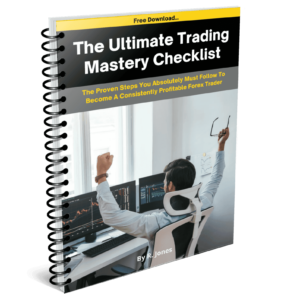Are you tired of struggling in the markets? Do you feel as if trading success is just beyond your reach?
Well, don’t worry – we’ve got you covered! With our ultimate Forex trading plan template, you’ll be mastering the markets and crushing it with consistent profits. Don’t believe us? Keep reading and see for yourself!
We know what it’s like to feel overwhelmed by all the information out there about Forex trading. That’s why we developed this easy-to-follow template that will give you a roadmap to becoming an unstoppable force in the markets.
We’re here to help make sure that your dreams of financial freedom become reality. So grab a cup of coffee (or tea!) and get ready to start your journey on becoming a master trader today!
What Is A Trading Plan?
Are you ready to take control of the markets and make a consistent profit?
A trading plan is your ticket to success! With a good trading plan, you can efficiently manage risk/reward, use both technical and fundamental analysis, go short or long in the market with limit orders and stop-losses.
It’s like having an automated assistant who helps you navigate the complexities of forex trading.
So don’t wait – start planning for success today! No more excuses; it’s time to master the markets!
Benefits Of Having A Trading Plan
Putting together a trading plan is like taking your investment psychology to the next level. It’s an incredibly powerful way of formulating a strategy for consistent profits by setting clear buying and selling criteria, daily strategies, and position sizing.
If you don’t have a plan in place already, it’s time to start one! Not only does having a trading plan help you make decisions faster and more confidently, but it also helps keep emotion out of the equation – something that’s key when it comes to successful trading.
With a solid trading plan under your belt, you can take control of your investments with confidence and begin mastering the markets like never before.

Building Your Trading Plan
Building your trading plan is about more than just crunching numbers. It’s also about understanding the psychology of trading and how to use discretion in a consistent way that produces profits.
Position sizing, risk capital, and time frames are all important pieces of the puzzle when it comes to crafting an effective trading plan. And while there may be no one-size-fits-all solution for every trader, by taking the time to understand these concepts you can create a powerful plan that works for your needs.
With this knowledge in hand, you’ll be well on your way to mastering the markets!
Understanding The Markets
It’s often said that knowledge is power, and in the world of trading, an understanding of market cycles, investment strategies and the psychology impact on trading are invaluable tools.
The key to consistent profits isn’t just having a template for your forex trading plan – it’s also about mastering your emotional control when executing trades.
Maintaining composure during periods of volatility can be one of the biggest challenges traders face; however, with a clear head and self-discipline you’ll be able to navigate these choppy waters easily.
After all, any successful trader will tell you that the battle is won or lost in the mind.
So make sure you focus on improving yourself as well as your technical skills if you want to stay ahead of the game!
Set Realistic Goals
When it comes to mastering the markets, setting realistic goals is a cornerstone of success. It’s important to prioritize both long-term and short-term objectives so that you can stay focused on your ultimate goal – consistent profits in the forex market!
To help you get started with goal setting, I’ve created this handy two column table:
| Time Frames | Goal Examples |
|---|---|
| Short Term (< 1 month) | Develop a plan for trading psychology <br>Create an effective reward system<br>Identify potential mental blocks |
| Long Term (1+ months) | Invest in additional education<br>Expand knowledge base of strategies used by other traders<br>Increase understanding of financial markets & instruments |
Setting clear goals will make all the difference when it comes to reaching your desired results in the forex market. Start off small and build up from there; once you have achieved those first few milestones you’ll be better equipped to tackle bigger challenges down the line.
So what are you waiting for?
Get out there and start creating small wins today – they add up surprisingly quickly!

Research And Analysis
Setting realistic goals is the first step in any successful trading plan.
Now, it’s time to do some research and analysis so that you can get closer to achieving those goals!
Analyzing data, understanding technical indicators, recognizing the psychology of trading and staying up-to-date on market trends are all key components when backtesting strategies for consistent profits.
While there is no guarantee for success in Forex trading, having a dynamic plan with plenty of research and analysis behind it will put you ahead of the game and increase your chances of success significantly.
With this knowledge, you’ll be ready to take on currency markets like never before!
Money Management Strategies
Money management is like a carefully crafted piece of art. It takes time and precision to ensure that you’re making the most out of your trades without putting yourself at too much risk.
Before entering any market, it’s essential to consider various time frames, analyse market trends, understand your own risk tolerance and leverage ratios, as well as pay attention to position sizing.
All these elements need to be taken into account when crafting an effective money management plan – otherwise all your hard work will go down the drain if you don’t know how to manage those profits!
As long as you keep all these pieces in mind while trading, you can rest assured that consistent profits are just around the corner.
Risk Management Rules
Having a solid money management strategy is only half the battle for becoming a successful trader – you must also understand and implement risk management rules. It’s all about striking the right balance between reward and risk, something that can be difficult to do without an established plan in place.
To help with this balancing act, let’s take a look at some of the most important elements of effective risk management in a 3 column by 5 row table:
| Element | Definition | Action Required |
|---|---|---|
| Risk Tolerance | The amount of risk one is willing to accept when trading | Establish your own personal acceptable level of risk before entering into any trade |
| Risk Assessment | A process used to identify potential risks associated with each trade or investment opportunity so that proper precautions can be taken to avoid losses. | Analyze both sides of every trade before taking action – use technical indicators and fundamental analysis as appropriate |
| Reward/Risk Ratio (RRR) | A measure commonly used to determine whether an investment might be worth pursuing; it compares the expected return on an investment against its associated level of risk. | Evaluate RRRs for each prospective trade; if the ratio is too low, consider passing on the opportunity as there may not be enough upside potential relative to downside risk |
| Stop Losses (SL) Orders | An order placed with your broker which sets limits on how much you are willing to lose in case the market moves against you | Set SL orders according to your predetermined levels of acceptable loss per trade; these orders should never exceed those levels no matter what happens during the course of a single day’s trading session |
| Position Sizing Strategy | Used to manage capital allocations while limiting individual exposure. This helps reduce overall portfolio volatility while still allowing traders/investors to participate in potentially profitable opportunities. | Determine position size based on both account size and individual comfort level with regard to amount risked; this will vary from person-to-person but should always follow pre-set guidelines regardless of what type of asset class is being traded. |
Now that we have outlined some key principles behind successful risk management, let’s move onto strategies for success!

Preparing For The Market
The market is a wild animal, and taming it takes dedication, hard work, and incredible skill.
To prepare for the markets, traders must understand how to follow trends, measure market volatility, use technical indicators, assess risk appropriately and develop their own trading psychology.
From mastering the basics of reading charts through to understanding complex algorithms that drive automated trading systems – it’s not easy to make consistent profits in this highly competitive arena.
But by taking time to learn the ropes and developing your own unique strategy, you can become an unstoppable force in the markets!
Getting started requires nothing short of superhuman courage – but with careful preparation comes great reward!
Pre-Market Routine
Now that you have a plan, it’s time to get into pre-market routine.
Before each trading session starts, meditate on what the market has in store for you and how you can best prepare yourself mentally and emotionally. Keeping a journal of your thoughts during this meditation can be helpful when tracking habits or lack thereof.
As part of your pre-market ritual, focus on developing a strong relationship with the markets so that you can become better at understanding and predicting their movements. Remember to keep an open mind while focusing on staying positive no matter what happens in the markets.
Finally, take some time every day to read up on trading psychology and apply these concepts as much as possible to ensure consistent profits over time.
Visualization Techniques
Visualization techniques are not just a powerful tool for traders, they’re the holy grail of successful trading! From trend forecasting to chart analysis and automation strategies to risk diversification and market timing – these methods really can turn any trader into an unstoppable force in the markets.
| Trend Forecasting | Chart Analysis |
|---|---|
| Automation Strategies | Risk Diversification |
| Market Timing | Profitability Maximization |
These visualization techniques have become so popular because they make it easier than ever before to make accurate predictions about what could happen next in the markets.
Not only do they provide insights that would otherwise be impossible or nearly impossible to uncover, but they also give traders the ability to identify patterns quickly which helps reduce their overall risk exposure significantly. Plus, with automated tools like robots you can even set up your own custom rulesets allowing you to take advantage of price movements without having to manually monitor them all day long.
Put simply – there is no better way for any trader out there looking for consistent profits in the forex markets than using visualization techniques. With this knowledge in hand, we can now go on our journey towards mastering the markets and achieving financial success!

Trading Rules
It’s time to get down to business!
To be a successful trader, you need an airtight trading plan that outlines your rules and regulations. And like any good captain, these should include the key components of trading psychology, technical indicators, order types, time frames, and broker selection.
It’s all about having the right strategy for navigating the markets and making consistent profits. So let’s dive into each of these elements so you can set yourself up for success – no matter what market conditions may come your way.
After all, if you have a well-executed game plan in place it’ll give you the confidence needed to keep calm when things start getting choppy out there on the waves of forex!
Trade Setups And Entries
Have you ever wondered what the secret to consistently profitable forex trading is?
Well, in this section we are going to discuss trade setups and entries that can help you achieve your goal. We will look at how using supporting signals, volatility filters, price action, candlestick patterns and risk reward ratios can give you an edge over other traders.
When it comes to identifying potential trades, these five elements should be taken into account together as they create a powerful combination for success when used correctly. Instead of relying on luck or gut feeling alone, having a plan based on sound analysis backed up by real data gives any trader a much better chance of making consistent gains in their chosen markets – no matter their level of experience!
So get ready to learn all about trade setups and entries – the cornerstone of successful forex trading!
After-Market Routine
Developing a consistent and successful forex trading plan requires some daily discipline, psychological preparation, and knowledge of technical indicators.
After-market routine should be part of your strategy to stay on top of the markets. Make sure you understand basic concepts such as position sizing and pattern recognition – these will help you make better decisions when it comes to setting up trades.
It’s also important to take time away from the market in order to avoid fatigue or emotional decision making. Taking breaks allows you to come back with fresh eyes and evaluate what has happened since the last trading session ended.
By having an after-market routine that involves more than just monitoring charts, you can keep yourself focused, stress free, and ready for whatever the next day brings.

Controlling Your Emotions
It’s no secret that the path to successful trading lies in mastering emotions – and yet, it’s often overlooked. According to research from the National Bureau of Economic Research, over 95% of traders don’t take any measures to control their feelings, leading them to make costly mistakes. So how do you go about controlling your emotional triggers?
| Tactics | Description |
|---|---|
| Trading Psychology | Understanding the psychological pressures associated with trading can help you better manage fear, greed and other emotions |
| Fear Management | Learning techniques such as deep breathing or mindfulness meditation can help reduce stress by calming your mind during high-pressure situations |
| Greed Avoidance | Taking breaks between trades and setting a realistic profit target helps keep greed at bay and improves decision making abilities |
| Confidence Building | Following a proven strategy, understanding risk management principles and developing an independent mindset are key for building confidence when trading markets. |
The importance of maintaining an emotional equilibrium during times of market volatility cannot be understated. To stay consistent in trading profits, one must learn to balance emotion with logic – something that comes with practice but is ultimately essential for success in today’s fast paced markets.
Developing An Action Plan
Now it’s time to put the plan into action!
This means tracking your performance, creating benchmarks, understanding psychology and monitoring risk.
It also requires mastering technical analysis so you can make informed decisions about when to buy or sell currencies.
All of this is necessary for consistent profits in the forex markets.
So buckle up and get ready to start trading – success awaits!
Tracking Your Progress
Tracking your progress is a crucial part of any successful forex trading plan.
You need to track metrics, review performance, measure success, identify trends and set benchmarks in order to stay on course and achieve consistent profits.
Monitoring the markets can be overwhelming at first so it’s important to take things one step at a time—break down each task into small chunks that are easy for you to handle.
And don’t forget that this isn’t a race!
Take your time when reviewing data or setting goals; if something doesn’t make sense, ask questions until it does.
With patience and discipline comes success, so keep at it and watch those profits roll in.

Leveraging Your Trading Plan
Now, let’s talk about how you can leverage your trading plan to stay ahead of the markets.
The psychology behind trading is essential for success and should be incorporated into your strategy. To make sure that it remains in check, keep these five key points in mind:
- Understand the market movements
- Adopt a risk management system
- Practice proper mindset development
- Research different strategies thoroughly
- Remain consistent with your trades
With all this taken care of, you should be able to achieve long-term profits while minimizing losses along the way.
So now that we’ve established what goes into developing an effective trading plan template – it’s time to get out there and start making some money!
The Power Of Having A Side Income
Having a side income through trading is the ultimate way to achieve financial freedom.
It requires discipline, practice and risk mitigation – but when you get it right, the rewards are huge!
Passive income streams can provide an extra cushion between your main job and retirement, while giving you more money to invest in other ventures or save for future goals.
Trading psychology also plays an important role in protecting yourself from making reckless decisions that could cost you dearly.
So make sure to take some time out of every day just to stay on top of what’s going on with the markets, set realistic expectations for yourself and review your own performance regularly.
This will help ensure that you remain consistent and profitable over time.
Frequently Asked Questions
How Much Money Do I Need To Start Trading?
Are you ready to take the plunge into Forex trading but don’t know how much money you need? It’s a valid concern and an important question that needs addressing before taking the first steps.
To get started, you’ll need at least a few hundred pounds, but ideally more in order to start trading responsibly.
On top of this, it’s vital to understand risk management, money management, technical analysis, fundamental analysis and trading psychology – all essential components for any successful trader.
The key here is to make sure your emotions are kept in check as well; otherwise it could be a wild ride with plenty of highs and lows!
What Tools Are Available To Help Me Track My Trading Performance?
Are you looking to get serious about your trading performance?
Well, if so, there are plenty of tools available that can help! From technical analysis and risk management to demo trading and leverage trading – the markets offer a wealth of opportunities for those who know how to use them.
Plus, market analysis is even easier these days with all the amazing platforms and software developers out there. So don’t let yourself be intimidated by a lack of information; make sure you take advantage of every resource available and master the markets in no time!

What Is The Best Strategy For Long-Term Trading?
When it comes to long-term trading, the best strategy is one that combines analyzing trends with position sizing, risk management and money management techniques.
Technical analysis also plays a big part in forecasting future movements of the markets – so if you’re looking for consistent profits over time then this approach is definitely worth considering!
It’s important to remember though that no matter how experienced you are as a trader, there will always be some level of uncertainty involved – which means having an effective plan in place can make all the difference when it comes to achieving your goals.
How Do I Know When To Enter Or Exit A Trade?
Knowing when to enter or exit a trade can be the difference between success and failure in the forex market.
To help, analyzing trends, timing techniques, fundamental analysis and technical analysis are necessary tools for any trader.
Risk management is also essential – you have to know how much of your capital you’re willing to risk with each move.
All this combined can help ensure that decisions are made at just the right time so profits keep rolling in!
What Measures Can I Take To Reduce My Risk Of Loss?
Are you looking for ways to reduce your risk of loss when trading? Look no further!
While stop-loss orders, technical analysis, and money management are all important elements in any trader’s toolkit, one of the most effective measures traders can take is to utilize leverage ratios.
By adjusting the ratio of borrowed capital to personal funds used in a trade – or simply using less leveraged trades – it’s possible to mitigate losses while still taking advantage of high potential returns.
So don’t be afraid – with proper risk management, you’ll be able to make intelligent decisions without sacrificing too much.
Conclusion
It’s important to remember that trading is not a get-rich-quick scheme. Investing in the markets requires knowledge, skill and discipline.
With the right tools and strategies, you can build a consistent forex trading plan template for long-term profits.
By mastering the markets, you’re taking control of your financial future and reducing your risk of loss.
As you continue to educate yourself on strategies and resources available to you, you’ll develop greater confidence in your trading decisions—and be better equipped to make wise investments.


